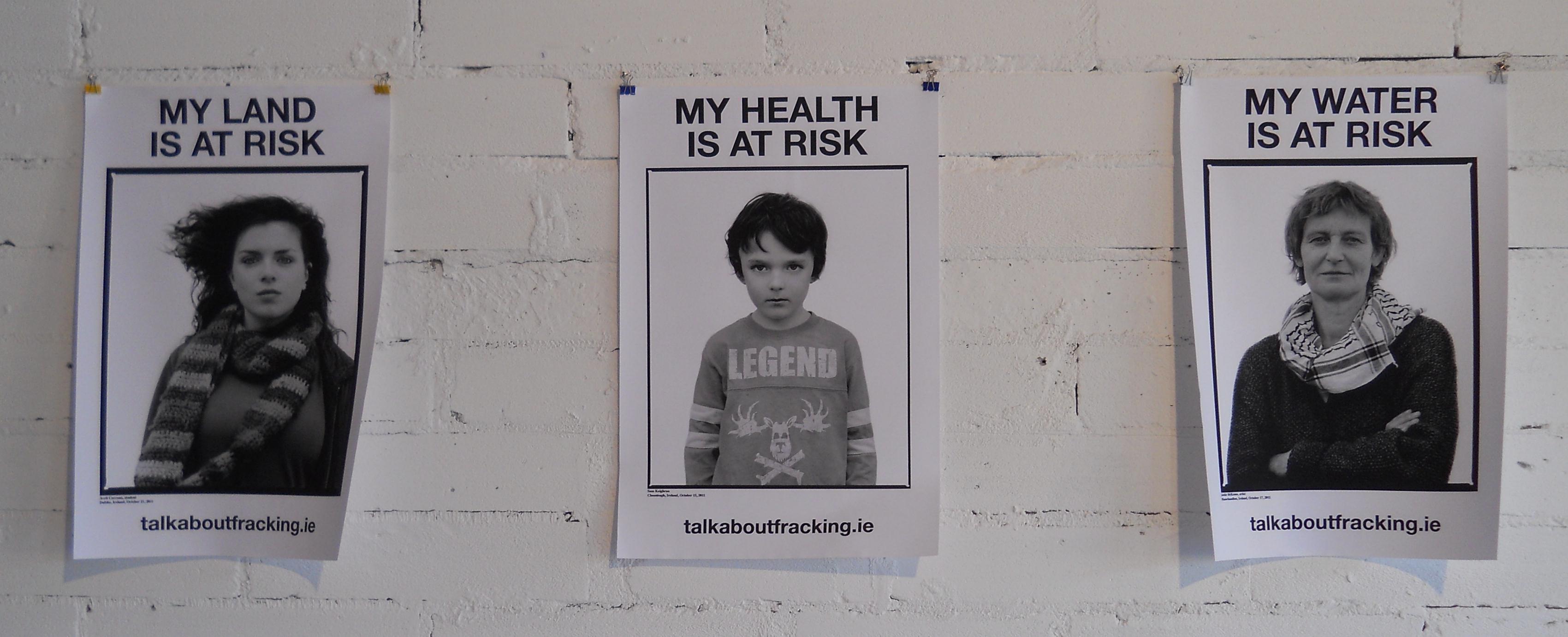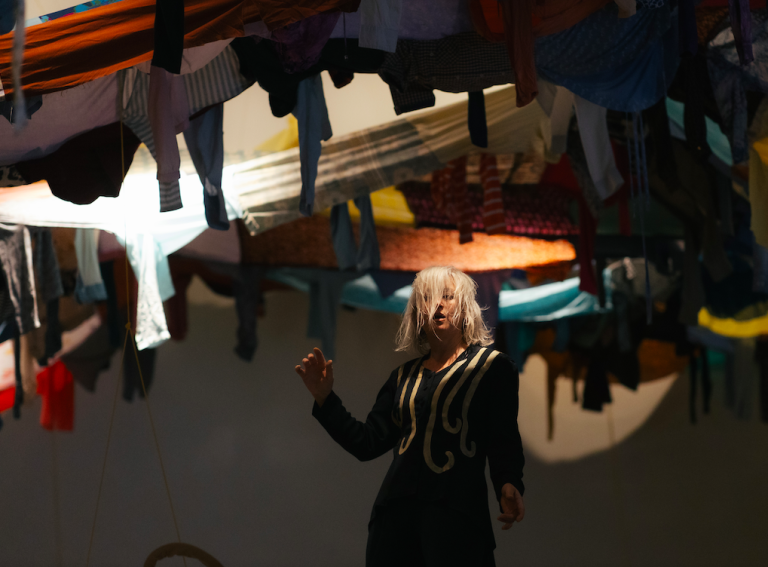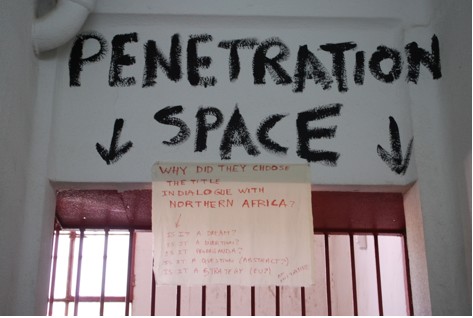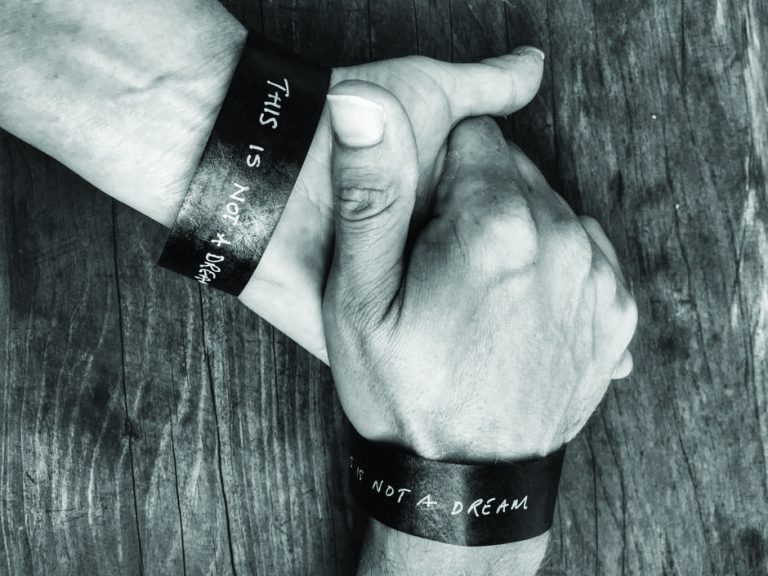TRADE is an annual Visual Arts Programme supported by Leitrim and Roscommon County Councils, and the Arts Council of Ireland. The initiative consists of a residency phase, where four local artists work under the mentorship of an invited artist, and a seminar event – which has historically displayed a substantial engagement with current critical discourse. In providing a platform for ‘local artists to engage internationally as well as for international artists to participate locally’, an interesting legacy has evolved out of contributions from an array of national and international participating artists, curators and thinkers.
The 2011 TRADE Seminar took place on Friday 2nd and Saturday 3rd December. Keynote speakers for the weekend were artists Philip Napier and Audrey Reynolds, current artist-in-residence David Michalek, and invited European curators Rafael López Borrego, (Director of Programming of DA2 Centre of Contemporary Art, Salamanca, Spain) and Dobrila Denegri (Director of Centre of Contemporary Art, Torún, Poland). The weekend was facilitated by Declan McGonagle, Belinda McKeon, Sarah Searson and Eilís Lavelle, and coordinated by Alice Lyons and Philip Delamere. Linda Shevlin coordinated a Resource Room.
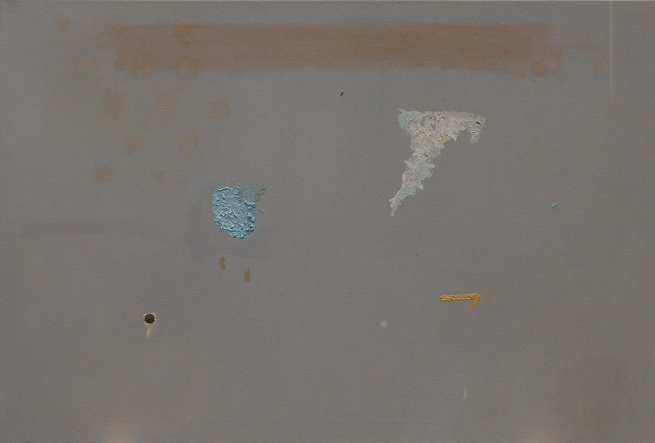
Audrey Reynolds: Of 3, oil on canvas, metal button
92 x 61 cm, 2008
Image held courtesy of the artist.
The Friday morning session began with contributions from the three invited artists, who each provided an insight into the evolution of their respective practices. Audrey Reynolds, in discussion with Eilís Lavelle, offered an illuminating insight into her ways of thinking and making, which in turn, extended the parameters of reception for her exhibition ‘Bayard Eade’, which was on show in The Dock at that time. The exhibition involved the formal elements of painting, sculpture and installation. The recent introduction of audio into her work (which Eilís described as a generous provision of a third space) produced a monologue of her own voice, which, for me, functioned as the conceptual epicentre from which all other floating elements could plot their co-ordinates. It was suggested that the audio presence may function as a title or para-text for the artwork. Stating that she is a self-taught writer, Audrey’s attentive and descriptive use of vocabulary felt quite unique, and, strangely, her words seamed to resonate with the same frequency as her artwork, embodying the ‘shimmering relationship’ between language and art. Discussing her term ‘insignification’, which has developed out of her on-going practice-based PhD, she spoke about the space in which theory and work collide, or sculpture and picture come to exist together. “This is not a brutish, crude mixture” she explains – “Subtlety comes from an intensive investment in each element”.
In conversation with Declan McGonagle, New York based artist David Michalek outlined his own transition from fashion photography into the visual arts, reflecting on some of the pivotal moments in his career. He spoke eloquently about his task of reconciling these two conflicting worlds, while negotiating involvement in community arts projects and work as an educator. He identified the prickly issue of ‘beauty’ as a concept he found the art world to be particularly resistant to. It is hard to imagine an art term more laden with baggage. The reactionary ‘anti-aesthetic’ was cultivated in art to fundamentally ‘deny the idea of a privileged aesthetic realm,’ carving out a politically engaged, interdisciplinary position for art. Rooted in the modern vernacular, this stance rejected enlightenment concepts pertaining to art and beauty, and advocated the idea that art is communally or culturally produced. Personally, any resistance does not occur in the experience of beauty itself, but in the rhetoric that often surrounds it.
Phillip Napier, in the presence of Sarah Searson, performed a monologue which used his current body of work Unpacking the Terror (exhibited in The Dock, July/August 2011) as a point of departure. Responding with agility to Phillip Napier’s reluctance to converse, Sarah adopted instead the role of pitcher, occasionally throwing images in the air for Phillip Napier to snatch and weave into his unfolding performative inquiry. His dialogue was substantial, active, and full of potent imagery. Using the M1 motorway (which connects Dublin and Belfast) as a metaphor for notions of a ‘borderless world’ promoted by ‘industrial logic’ and globalisation theories, Phillip Napier employed tangential descriptions to map out connections between things;- national outlooks and global perspectives; the everyday act and implications within the wider political domain; the historical event or forgotten monument crystallised in the present through the constant re-inscription of its loss. “How does geography shape new realities? What might we do now? Is it still possible to posit ‘frontier discovery’ over established routes? To connect with whom? Art is a good site for questions like these.” His presentation concluded with a performance involving a polar bear hide and some traffic lights, simulating a temporary monument marking a site at the convergence of disparate routes.
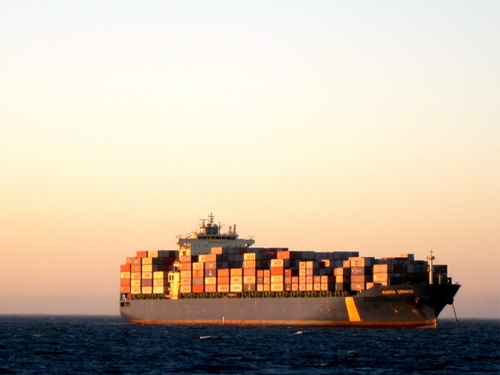
Phillip Napier: Expecting the Terror
The Dock, Carrick-on-Shannon, 2011
Image held courtesy of the artist.
The afternoon session commenced with a group discussion between the three artists, mediated by Belinda McKeon, who made her position clear quite early on, adopting the role of devil’s advocate, delivering incisive observations, moderated with sincerity and humour. Debate of any kind needs some oppositional presence in order to move thinking forward, and artistic thought acknowledges the value of suitable adversaries. The challenge? To penetrate the veneer of ‘art-talk’, with the purpose of identifying how ‘live’ these terms actually are, in the hope of creating something substantial and enduring; “What will be the legacy of this weekend?”
Bizarrely, the first opportunity for conflict arose in a disagreement about grammar; whether ‘art’ is a noun or a verb; a ‘thing’ or a process of doing. Now, I’m all for conceptual free-association and tangential departure, but art as a doing word? Surely thou art mistaken? After this, I was vigilant towards any further grammatical extrapolation. I subsequently became increasingly aware of Phillip Napier’s tendency to speak in the present continuous tense. I am noticing this, and I am wondering whether this (coupled with the fact that he is inclined to pace while talking) is in fact a grammatical portal into the present moment – an active, unfolding moment – where I am in the process of considering, but I have the capacity to change my direction at any time.
In the late afternoon, invited international curators Dobrila Denegri and Rafael López Borrego provided an insight into art and exhibition-making in their respective European institutional contexts, with reference to socio-economic infrastructures and shifting notions of public. Dobrila is an art historian and curator, and currently lives and works between Rome, Belgrade (Serbia) and Torún (Poland). Her presentation centred on her involvement in an independent cultural project for young artists in Belgrade, ‘Real Presence’, which ran annually for ten years. Originally intended as a one-day workshop, the call out attracted 300 art students, who stayed for two weeks, transforming the city into a 24-hour art space. Executed on a tiny budget of €2500, the unfolding project required imagination and resourcefulness; hospitality merged with concepts of sharing – thoughts, time, food, life itself. This sense of exchange was the legacy of the project, marked by subsequent future collaborations in other European institutional contexts. There was a sense of isolation at the time in Belgrade amidst the socio-economic and cultural crisis created by ten years of war under Miloševi?’s rule. In contrast, Dobrila’s current position in Torún exists amidst an economic boom for Poland, with investments in culture, infrastructure and resources opening up an opportunity for the museum to create an international perspective. Conversely, the economic crisis in Rome is deep.
Concurring with the theme of European economic instability, Rafael López Borrego outlined his involvement as director of programming at DA2 in Salamanca, Spain. He spoke of consistent work done over the last number of years in creating important inter-relationships with other provincial museums, while also establishing an international profile. There was always a commitment to support emerging local artists, while also show-casing established international artists, with the intention of attracting visitors and supporting tourism – Salamanca’s main industry. With the economic recession in Spain, funding and resources are now extremely limited.
On Friday evening there was an opening of an exhibition by the artists who participated in this year’s TRADE residency, located in two adjacent, dis-used commercial premises in the town centre. David Pierce, David Spence, Stephen Rennicks and Brigitta Varadi worked for 9 months under the mentorship of artist David Michalek, establishing the ‘Engage Artist Collective’, with the intention of filtering their individual practices through this group format. Out of this collaboration grew a campaign ‘Talk About Fracking’, which aims to raise awareness about the very current issue of hydraulic fracturing (a.k.a ‘fracking’) for gas in Ireland. Proposed site maps, and archival material presented at the exhibition, coupled with a presentation by Dr Aedín McLoughlin of Glenwood Research, illustrated the impact of such heavy industrialisation for the local area and its residents, amidst broader national implications.
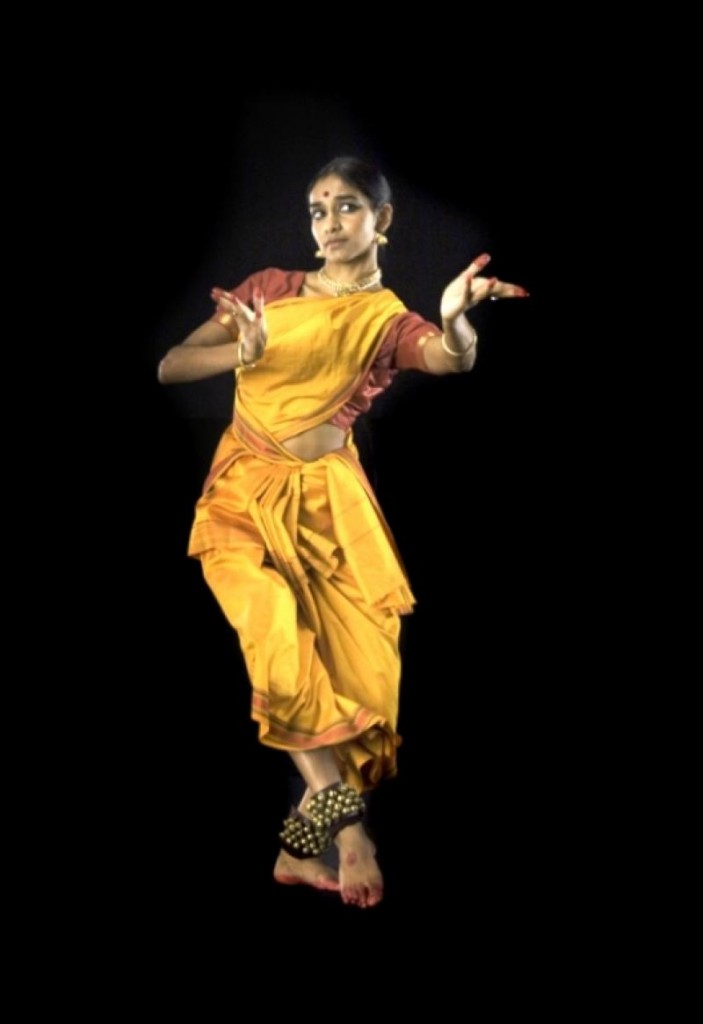
David Michalek: Slow Dancing at Trafalgar Square, 2010
Dancer: Shantala Shivalingappa
Image courtesy of the artist.
Benefitting from the influence and expertise of David Michalek, the group produced a series of posters and postcards, consisting of photographic portraits of local people alongside statements such as ‘My health is at risk’, my land/ my farm/ my family/my town/my future.. Employing a format and vocabulary reminiscent of other national campaigns, this approach articulates a commercial awareness that becomes something other than art, yet resonating at the heart of the project is the important role the artist plays in advocating active citizenship.
Opening the exhibition, Declan McGonagle spoke candidly about the responsibility of the artist in this regard, verbalising a stimulating inquiry into the social function of art itself – is it a form of ‘entertainment’? A distraction, an anecdote? The image of the artist existing outside of society has persisted for over a century and remains the dominant model, because most of our current critical apparatus supports ‘art as entertainment’, therefore defining art as a servant of the economy. Conversely, art, when viewed as a form of knowledge, can ask ‘what kind of society do we want? How can economy support this?’ Identifying their place in the world, artists can cultivate a new fidelity to the ‘local’, resisting the homogeny of globalised systems, by focusing on those micro issues (e.g. fracking) that question the broader body politic (e.g. how the land is monetised, how life is measured in the context of money, what a nation means to its citizens).
Out of this revival of collectivism, he suggested with enthusiasm, new forms of knowledge can emerge, redefining art as a participatory, reciprocal, collaborative mode of exchange between the artist and non-artist. This process is less about the economic functionality of the art object and more about the purpose – the quality of interaction: “Art should not be an anecdote to reality, rather a way for non-art public to negotiate knowledge. By default, in a period of economic collapse, new propositions can emerge.”
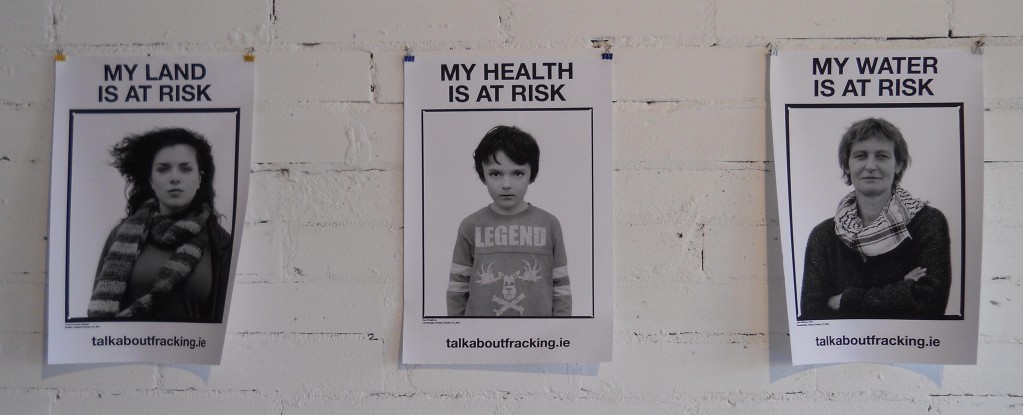
Engage Collective: Talk About Fracking
Carrick-on-Shannon, 2011
Image courtesy of the artists.
This inquiry was continued the following morning, in a discussion between the Engage Collective artists, Davis Michalek and Eilís Lavelle. Brigitte Varadi spoke about her desire to negotiate her art practice with her community-based work. With the project ‘Talk About Fracking’, she experienced some ‘special, remarkable meetings’ with neighbours in the community, and began to look on these conversations as ‘the art itself’, while also commenting on a tangible shift in the community’s perception of the artist as a potential vehicle towards something. Alluding to a Duchampian ‘extended definition of Art’, David Michalek considered whether the campaign may be a step towards ‘social sculpture’, which claims a participatory role in shaping society. In response to Eilís Lavelle’s query regarding how an artist may negotiate ‘issue tourism’ with regard to ethics and the appropriation of knowledge, Stephen Rennicks emphasised the importance of consultation with experts, whose responsiveness was usually determined by how they were initially approached – an ethos of inclusivity produces a relationship based on trust.
The general merits of TRADE as a working model for mentorship and artistic development, was expanded upon when four artists from previous residencies (Anna McLeod, Anna Spearman, Róisín Loughrey and Angie Duignan) reflected on their experiences, outlining how their own artistic practices have evolved. Anna Spearman spoke of the open-ended nature of the TRADE residency, with no pressure for end results, and the role of the mentor as a generous sounding board, which contribute to the main function of TRADE – to provide a critical and discursive space for the interrogation of practice. Co-incidentally, they have all since gone on to study on M.A programmes, highlighting, perhaps, a desire for critical input and mentorship that education provides.
TRADE is always accompanied by a resource room, which provides access to resources, advice and practical information, re-affirming the functional ethos of the initiative. This year, the information point was coordinated by Linda Shevlin, who sourced an abundance of publications and reading material, detailing national and international opportunities, and residencies for artists. She collated this information into a concise, user-friendly document (published with support from Cultural Contact Point Ireland), prioritising funded residencies where artists are generally required to make a non-monetary contribution towards a project in the form of skills, research or community intervention.
The penultimate session of the weekend was executed in a room-hopping frenzy between ten minute sessions on suggested key topics for discussion – a kind of speed dating for criticality. The three sessions I attended offered up some interesting reflections on how artists may navigate a position within this socio-economic ‘crisis moment’, finding ways of operating outside of economic models. Does an uncommodifiable ‘sacred space’ exist? Is it outside or within society? A desirable position, it was suggested, would be to be ‘in it’, but ‘aware’ in it. In facilitating a summary of the weekend, Alice Lyons proposed a poetic use of the term ‘fracking’, as a way of identifying the main issues that deserve to be drilled and extracted through the fracturing process. Declan McGonagle supported this symbolic use of fracking as a metaphor for energy production – seminar discussions like TRADE are valuable as they propel us closer towards uncovering the ‘something else’ that will be delivered, the substance that may fill the economic void.
Reporting on her observations of the group discussions, Belinda McKeon identified the issue of ownership within collaborative work – ‘the middle ground between mine and yours’- as an urgent, unresolved concern for the Engage Artist Collective. One artist in particular voiced his dissatisfaction with the issue of copyright, and clearly felt his contribution to the project was overshadowed by the working model of group ownership. The other members defended the group, concerned that this interjection may serve to undermine the integrity of the project. The atmosphere was tense. Bearing witness to this level of confrontation, an audience may feel discomfort, or compassion towards those involved, but on later reflection I feel this was a defining moment within the dialogue of the weekend. Firstly, it succeeded in highlighting the dichotomy between ‘collectivism’ as a fashionable buzz-word, and the real-world implementation of collaborative activity. In exposing the internal mechanisms of collectivism (the problems and practical implications) we can get a more tangible grasp of what it means to work together. The experiences of the Engage Artist Collective are indicative of core issues for collectivism as a working model, both historically and in contemporary revivals of the form: – How functional is this ‘communal understanding’ that the ownership of the process resides within the group as a unified entity? To what extent does the individual relinquish their own identity in favour of the group status?
Secondly, this inquiry has obvious resonance within a wider spectrum of political discourse. In a year defined by a wave of collective resistance, Arab Spring and global Occupy movements, it becomes unavoidable to a least acknowledge that different political models organise their society based on their configuration of the individual . Collectivism, although often formed out of practical necessity for sharing and pooling resources, defining itself via self-organisation and self-sufficiency, pitches itself in opposition to the competitive and increasingly exploitable individual, existing under capitalism. It is hard to identify a more urgent inquiry.
“There is no manual to negotiation or collaboration,” stated Declan McGonagle. [Paraphrasing] “This conference is not an instruction manual, being a victim is not an option. This weekend has served to highlight the artist’s own responsibility to name possibilities for themselves – to make transparent their own position. It is not good enough to complain, requiring that something be provided – rain is wet, get an umbrella.” Reflecting on the notion of ‘artist as active citizen’ as a dominant theme of the seminar, he spoke with authority about the current political and socio-economic situation in which we must continue to negotiate a role for art. The concept of the artist as a figure outside society is an outmoded construct of Romanticism. The ‘sacred space’ for art is, in fact, embedded within the fabric of society, to mediate, construct and disseminate new models of knowledge. “Now”, he concluded with optimism, “is a remarkable time to be an artist.”
Joanne Laws is a writer based in Leitrim.
[i] Hal Foster, “The Anti-Aesthetic, Essays on Postmodern Culture” (Seattle: Bay Press, 1983)
[ii] Enlightenment concepts:
- Great art was the product of the imaginative or intellectual powers of an individual genius (an imaginary figure, isolated from society).
- Beauty or aesthetic value in art could only be appreciated by those cultured enough to recognise it. Judgement on art was not culturally embedded, but derived from the individual’s taste and/or education.
[iii] “Man is really not freeing many aspects. He is dependent on his social circumstances, but he is free in his thinking, and here is the point of origin of sculpture. For me the formation of the thought is already sculpture. The thought is sculpture.”
– Joseph Beuys
Carin Kuoni ed., Energy Plan for the Western Man: Joseph Beuys in America’ (New York: Four Walls Eight Windows, 1993) p.90
[iv] Individualists believe in the power of the individual and their capacity to assess their own needs. Liberalism offers an alternative to monarchy or religion and claims to value the individual’s freedom. Anarchists believe the state is unnecessary or harmful, whereas Statists such as Georg Wilhelm Friedrich Hegel believe that hierarchical structures, such as the state, are necessary to maintain order and morality, which in turn benefits the individual. Based on the theories of Hegel and Jean-Jacques Rousseau, Marx developed a collectivist approach to social structure, with emphasis on the group over the individual. Generally speaking, Collectivist political structures describe how the state ensures that the individual serve society. Totalitarianism is an extreme form of Collectivism.

